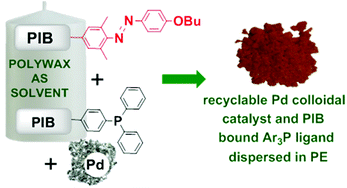Polyisobutylene (PIB)-bound azo dyes were prepared from aryl amine terminated polyisobutylene oligomers and used to form palladacycle precatalysts that can be used for catalytic carbon–carbon cross coupling reactions. The catalysts so formed were recyclable using thermomorphic heptane–DMF solutions that are monophasic at 80 °C and biphasic at room temperature. Under these conditions, the Pd catalyst can be recycled but some Pd leaches into the product solution. Using a low melting polyethylene oligomer as a solvent in place of the volatile heptane solvent reduces this leaching by roughly an order of magnitude. Further modification that involves using a second polyisobutylene (PIB)-bound phosphine ligand both increases the activity of the colloidal Pd catalyst and decreases the total Pd leaching by almost two orders of magnitude with 99.88% of the Pd being recovered. In this case, the Pd content in the solution of the product was ca. 0.3 ppm. These two modifications together lead to a much more sustainable strategy for the use of Pd colloidal catalysts in catalytic cross coupling chemistry.
